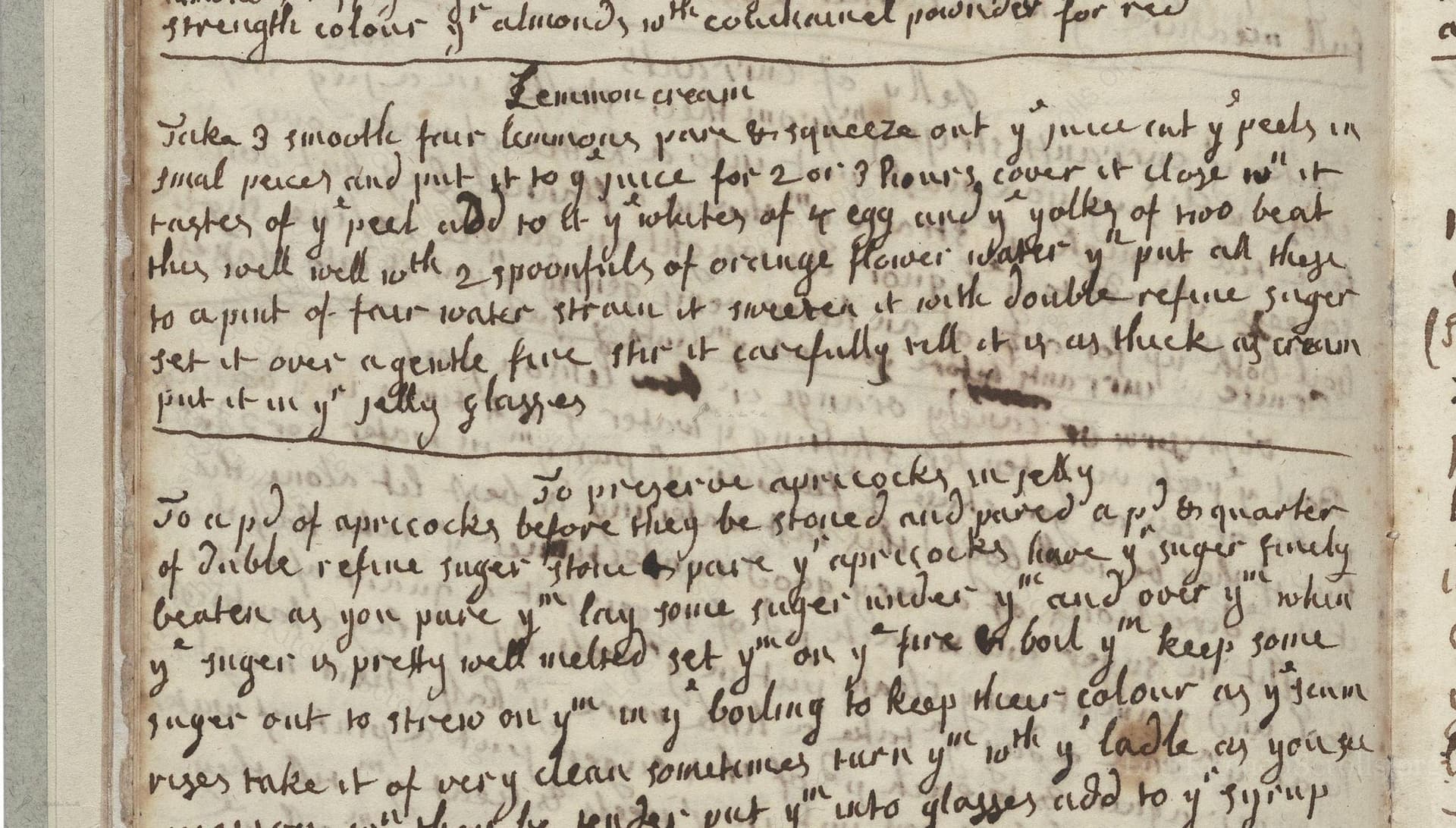Lemmon Cream
From the treasured pages of Mrs. Knight's receipt book
Written by Mrs. Knight

Lemmon Cream
"Take 3 smoothe fair lemmons, pare & squeese out the juice cut the peels in smal peices and put it to the juice for 2 or 3 hours, cover it close when it hath stood so long take half a pd of Double refine suger with 2 spoonefuls of orange flower water a pint of spring water put all these together with the lemmons & set it over a gentle fire stir it carefully till the suger is all melted then put it on the fire again & boil it till it will jelly & strain it into the jelly glasses."
Note on the Original Text
The recipe is written in the continuous prose style typical of 18th-century household manuscripts: no ingredient list, sparse punctuation, and variable spelling (e.g., 'lemmon' for 'lemon', 'squeese' for 'squeeze'). It assumes a cook's familiarity with basics such as jelly making and straining. Measurements are given by household measures (pint, spoonfuls) rather than precise weights, reflecting the variable nature of early modern cookery writing.

Title
Mrs. Knight's receipt book (1740)
You can also click the book image above to peruse the original tome
Writer
Mrs. Knight
Era
1740
Publisher
Unknown
Background
Step into the refined kitchens of 18th-century England with Mrs. Knight’s culinary collection, where time-honored recipes, hearty roasts, and elegant pastries await the enterprising cook.
Kindly made available by
Folger Shakespeare Library
This recipe comes from an English manuscript dated 1740, attributed to Mrs. Knight. It represents the elegant and refined pudding-making traditions of upper-class households in the 18th century. Citrus fruit such as lemons and imported flavorings like orange flower water were status ingredients, reflecting wealth and access to global trade. Jelly-based 'creams' like this were often served as a delicate finale at fashionable dinners. The technique combines infusion, gentle heating, and careful clarification—hallmarks of 18th-century European dessert-making, preceding the widespread use of commercial gelatin.

This recipe would have been prepared in a well-stocked kitchen using a paring knife for peeling, a citrus reamer or manual press for juicing, and a small copper or brass saucepan for heating. The straining was likely done through a muslin cloth or fine sieve. The jellied mixture would be poured into delicate glass jelly glasses, a status symbol of the period, for serving.
Prep Time
15 mins
Cook Time
15 mins
Servings
4
We've done our best to adapt this historical recipe for modern kitchens, but some details may still need refinement. We warmly welcome feedback from fellow cooks and culinary historians — your insights support the entire community!
Ingredients
- 3 smooth lemons
- 8 ounces superfine (caster) sugar
- 2 tablespoons (1 fl oz) orange flower water
- 2 cups spring water
Instructions
- Begin by washing and peeling 3 smooth, fair lemons.
- Squeeze out their juice and reserve.
- Cut the peels into small pieces and add them to the juice.
- Cover the mixture and let it infuse for 2 to 3 hours.
- After infusing, add 8 ounces of double-refined (superfine) sugar, 2 tablespoons (about 1 fluid ounce) of orange flower water, and 2 cups of spring water to the lemon mixture.
- Combine thoroughly.
- Gently heat the mixture, stirring until all the sugar dissolves.
- Increase the heat and bring to a light boil, cooking until the mixture reaches a jellied consistency (test by placing a spoonful on a cold plate to see if it firms up slightly).
- Strain the hot lemon cream into small dessert glasses or ramekins and allow to cool and set before enjoying.
Estimated Calories
110 per serving
Cooking Estimates
It takes a few minutes to prepare and peel the lemons, and then you let them infuse for a couple of hours. Cooking and dissolving the sugar happens quickly. When finished, each serving is a light, sweet citrus dessert with about 110 calories.
As noted above, we have made our best effort to translate and adapt this historical recipe for modern kitchens, taking into account ingredients nowadays, cooking techniques, measurements, and so on. However, historical recipes often contain assumptions that require interpretation.
We'd love for anyone to help improve these adaptations. Community contributions are highly welcome. If you have suggestions, corrections, or cooking tips based on your experience with this recipe, please share them below.
Join the Discussion
Rate This Recipe
Dietary Preference
Main Ingredients
Culinary Technique
Occasions

Den Bockfisch In Einer Fleisch Suppen Zu Kochen
This recipe hails from a German manuscript cookbook compiled in 1696, a time whe...

Die Grieß Nudlen Zumachen
This recipe comes from a rather mysterious manuscript cookbook, penned anonymous...

Ein Boudain
This recipe comes from an anonymous German-language manuscript cookbook from 169...

Ein Gesaltzen Citroni
This recipe, dating from 1696, comes from an extensive anonymous German cookbook...
Browse our complete collection of time-honored recipes



